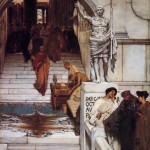 Criticised even by his contemporaries for his technique, subject matter, composition and financial success it sometimes seems he could do nothing right. Yet he was also praised for the very same by others. The paintings are the same,regardless of the viewer. What we have here, is as revealing of his critics as of the artist.
Criticised even by his contemporaries for his technique, subject matter, composition and financial success it sometimes seems he could do nothing right. Yet he was also praised for the very same by others. The paintings are the same,regardless of the viewer. What we have here, is as revealing of his critics as of the artist.
Alma-Tadema’s technique was born of Dutch and Flemish realism. Not the Rembrandt and Rubens kind (high drama and bravura), but Vermeer and Jan Brueghel the Elder (dead rabbits ,goblets and fruit). His emphasis on “photographic” finish pervaded the entire surface of the painting. This disturbed . The still life accessories are painted with the same level of intensity as the figures in his staged dramas, prompting one critic to lament there is no room for “the soul”. Others complained that this egalitarian attitude was dangerous subversion of the heirachic “order of things” and was a metaphor for “revolutionary “ political ideas.
Compounding the dilemna posed by his relentlessly even execution was his use of sometimes extreme cropping of figures at the edges, the dominance at times of what we would call “negative space”, and almost a refusal to give an “important” historical figure a central position. He was well aware of Japanese composition and photography , and used them not just as visual reference, but as emotive metaphor.This met the same critical incomprehension for him as it did for the Impressionists.
Confusing the issue further, his elaborately constructed “historical” pieces, all based on authoritative research, did not aim at authenticity entirely: rather the illusion of it. Historical artifacts would change scale, or a marble sculpture would be shown as the “bronze original”. Flowers would be used that weren’t introduced to Europe till centuries later.Architectural motifs from many sites would be combined into a “reconstruction” Most odd of all to some,and infuriating to Ruskin, was that the people in his paintings were portraits of himself, friends and family, rather than “ideal” patrician types.Despite all this playful invention, he is accused of a “lack of imagination”,because his work is ultimately “too?”convincing.
Perhaps what has irked the modernist critics from Roger Fry on ( who also showed no comprehension of Alma-Tadema’s compositional approach, accusing him of “lacking design”) was his obvious financial and artistic success. His patrons were the rich and powerful entrepeneurs of his day, all of whom “had to have” one or more of his works. The Medici built their riches on double entry bookkeeping, the Dutch invented the stock exchange, and the barons of Empire thrived on ruthless trade. All understood attention to detail, craftsmanship, and time consuming labour. All saw in one form of realism or another a reflection of their own values. To label Alma-Tadema a “reactionary” bourgeois is to chastise a duck for having feathers. A “reactionary” to one critic( Fry) and a “revolutionary”to another(Ruskin) illustrates my point. These political attacks are simply irrelevant.
It is true that Alma-Tadema’s historicism presented a world comfortably removed from the ugly side of life. He did not indulge in drawing allegorical parallels to contemporary political issues, preferring to deal in the main with simple human domestic drama transported to the Classical world. The problem with him is simply that he is the victim of his own success. His attention to surface texture is what drives him. Painting his beloved marble, furs, flowers, landscape, bronzes,textiles, figures, it seems he was voracious and almost indiscriminate. He was the consummate painter of surfaces, and as such was able to present a fantasy world so convincing that it confuses as much as it delights. Hence the criticisms based on the moral issues confronting the actors of his dramas. This was easy territory, and you didn’t have to know much about art to indulge in indignation.
His prodigious skill at rendering surface has its contemporary equivalent in computer generated imagery and its other worlds. He was one of the first and greatest exponents of Fantasy Art, and a reappraisal of his output could usefully use that frame of reference. He is the great-granddaddy of Photoshop and its composite images, and before that,an inspiration to Cecil B DeMille. Cinematically, his example survives. Gladiators still stir dust on our screens.
The question for the contemporary painter however is more vexed. Are there lessons to be learned from the “marbleous”painter? I believe there are. But that’s another story.
Brian E Deagon
2011-03-20
Essay based on Sir Lawrence Alma-Tadema. Elizabeth Prettejohn et al . Rizzoli
Exhibition Catalogue Date 1996. Kindly lent by Nick Leavey of Salisbury Studios.
Implications.
1. The composite image.
2. Degree of “finish” and its place in composition.
3. Political statement embedded in composition rather than subject matter
4. “Framing” a work in terms of its intended audience.
5. Values and assumptions inherent in “realism”
6. Photography, Photoshop and their legitimate use in painting
7. Centrally focused vision , peripheral vision, the time factor in the act of seeing (ie instantaneous single focus V the wandering eye constantly refocussing over the entire surface)
8. The contemporary predilection for the fragment and the ‘unfinished”
9. The revealing of “process” as opposed to rendering(literally) till process is hidden.
10. The artists ego revealed rather than the subject.
